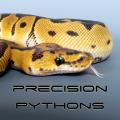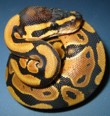» Site Navigation

0 members and 920 guests
No Members online
Most users ever online was 47,180, 07-16-2025 at 05:30 PM.
» Today's Birthdays

» Stats

Members: 75,945
Threads: 249,141
Posts: 2,572,339
Top Poster: JLC (31,651)
|
-
BPnet Veteran


Re: Dom x Normal
nope... now that I read Randy's post in more detail I realize I made a mistake.
homozygous x normal = 100% het. all would show the trait for a dominant gene.
1.0 Normal BP - "Snakey"
1.0 Jungle carpet python - "Chewbacca" aka "Chewie"
0.1 Olive python - "Cleopatra" aka "Cleo"
0.0.1 Corn - "Husker"
1.0 Veiled Chameleon - "Kermit"
-
-
BPnet Veteran


Re: Dom x Normal
 Originally Posted by ladywhipple02

Spider is dominant. There is no such thing as a het spider.
When you breed doms by normals, the ODDS* are that you will be get 50% morphs and 50% normals.
How can this be true? I can see that there would be no outward difference between a pure and het dominant. However, the snake can still carry either one or two copies of the morphed gene, right?
1.0 Normal BP - "Snakey"
1.0 Jungle carpet python - "Chewbacca" aka "Chewie"
0.1 Olive python - "Cleopatra" aka "Cleo"
0.0.1 Corn - "Husker"
1.0 Veiled Chameleon - "Kermit"
-
-
Re: Dom x Normal
so if 25% are normal and 50% HET how do you tell the difference.
-
-
Re: Dom x Normal
 Originally Posted by bearhart

for the general case of a dominant x normal I believe you have two possible cases:
pure morph x normal = 75% showing, and 25% normal. More specifically, you'd get 25% "pure", 50% het, and 25% normal. But, since its a dominant morph, 75% with show the trait.
het morph x normal = 25% het, 75% normal. For a dominant gene, you would have 25% showing the trait.
Correct?
By "pure" do you mean homozygous? In which case, per your later posts homozygous X normal does produce 100% hets just looking at the genotypes for the breeding results. You can then come along afterward and apply the mutation type and figure out that for a dominant mutation the hets look like their homozygous parent but have a different genotype so will have different breeding results when they are grown up and bred.
Het X normal would however produce eggs with a 50% chance of being hets and a 50% chance of being normal regardless of the mutation type but being a dominant type the hets would show.
The belief that "het" only applies to normal looking recessive hets I think goes back to the recessive snake morphs being where most of us first learned the term het. Outside of snakes, het is understood to mean having an unmatched pair of genes and doesn't necessarily tell you what the animal looks like (without knowing the mutation type) but is very useful in understanding its breeding results. By knowing that it has two different types to choose from you can see that each offspring has a 50/50 chance as to which version of the gene (in our case mutant or normal) it gets.
-
-
BPnet Veteran


Re: Dom x Normal
 Originally Posted by RandyRemington

By "pure" do you mean homozygous? In which case, per your later posts homozygous X normal does produce 100% hets just looking at the genotypes for the breeding results. You can then come along afterward and apply the mutation type and figure out that for a dominant mutation the hets look like their homozygous parent but have a different genotype so will have different breeding results when they are grown up and bred.
Het X normal would however produce eggs with a 50% chance of being hets and a 50% chance of being normal regardless of the mutation type but being a dominant type the hets would show.
The belief that "het" only applies to normal looking recessive hets I think goes back to the recessive snake morphs being where most of us first learned the term het. Outside of snakes, het is understood to mean having an unmatched pair of genes and doesn't necessarily tell you what the animal looks like (without knowing the mutation type) but is very useful in understanding its breeding results. By knowing that it has two different types to choose from you can see that each offspring has a 50/50 chance as to which version of the gene (in our case mutant or normal) it gets.
yea by "pure" I mean homozygous. I want to abbreviate like "het" but I can't bring myself to use "homo" since that's pretty much taken. 
But, yes I see my error now which is really the same as my original mistake. I was applying an even 25% chance to each gene, forgetting that the offspring has to have one from each parent.
1.0 Normal BP - "Snakey"
1.0 Jungle carpet python - "Chewbacca" aka "Chewie"
0.1 Olive python - "Cleopatra" aka "Cleo"
0.0.1 Corn - "Husker"
1.0 Veiled Chameleon - "Kermit"
-
-
BPnet Veteran

Re: Dom x Normal
 Originally Posted by NateDogg13

Dom x Normal = 50% showing morph
What my question is if you breed a dominant form to a normal and you get 50% showing are the others het for that morph or are they just normal?
Is it the same with codom and dom.
Ex: Spider x normal = 50% spider 25% het spider 25% normal
Pastel x normal = 50% pastel 50% het pastel
Ive heard spider is a codom morph but if I am wrong please correct me.
Is this correct or am I way off?
pastel is a co-dominant gene but can be considered "het for super pastel" because breeding pastel x pastel may give you the dominant gene super pastel. if a pastel is bred to a normal then you will get 50% chance of pastels and 50% chance of normals. the normals are not het for anything.
spider is considered a dominant gene because there is no super form when spider x spider are bred. if a spider is bred to a normal then you will get 50% chance of spiders and 50% chance of normals. the normals are not het for anything.
-
-
Re: Dom x Normal
[QUOTE=bigballs;662850]pastel is a co-dominant gene but can be considered "het for super pastel" because breeding pastel x pastel may give you the dominant gene super pastel. QUOTE]
Sorry to nitpick but the pastel mutation doesn't change from the co-dominant type to the dominant type when you are looking at a super pastel. The mutation type stays the same - co-dominant. It's the genotype that changes from heterozygous when looking at a pastel to homozygous when looking at a super pastel. The misuse of "dominant" for homozygous is very common and I believe may have even been published but adds to the confusion.
-
-
BPnet Veteran


Re: Dom x Normal
I know this has come up before...but isn't it kind of weird that there is no homozygous form of Spider? How is this possible, genetically speaking? The mother and father each give one copy of a gene to the child. If both parents were spiders (had one copy of the spider gene) then isn't there a 25% chance the offspring should inherit both copies? Is it the case that the homozygous form is lethal/ends up in slugs or is the gene located in such a way that two copies aren't possible??
If two copies were possible, then theoretically these homozygous spiders should produce ALL spider offspring when bread to a normal, and I know of no such spider existing.
JonV
-
-
BPnet Veteran


Re: Dom x Normal
 Originally Posted by nevohraalnavnoj

I know this has come up before...but isn't it kind of weird that there is no homozygous form of Spider? How is this possible, genetically speaking? The mother and father each give one copy of a gene to the child. If both parents were spiders (had one copy of the spider gene) then isn't there a 25% chance the offspring should inherit both copies? Is it the case that the homozygous form is lethal/ends up in slugs or is the gene located in such a way that two copies aren't possible??
If two copies were possible, then theoretically these homozygous spiders should produce ALL spider offspring when bread to a normal, and I know of no such spider existing.
JonV
This is pretty much what was just said. A homozygous morph bred with a normal with produce 100% hets. In the case of a dominant gene, all of the offspring will show the mutation.
1.0 Normal BP - "Snakey"
1.0 Jungle carpet python - "Chewbacca" aka "Chewie"
0.1 Olive python - "Cleopatra" aka "Cleo"
0.0.1 Corn - "Husker"
1.0 Veiled Chameleon - "Kermit"
-
-
Registered User


-
 Posting Permissions
Posting Permissions
- You may not post new threads
- You may not post replies
- You may not post attachments
- You may not edit your posts
-
Forum Rules
|